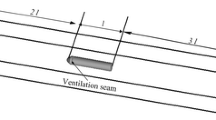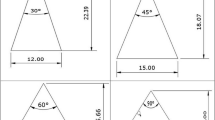Abstract
Based on the Reynolds-Averaged Navier-Stokes equations and mass transfer model, an approach, where a three-component cavitation model is proposed, is presented to simulate ventilated cavitating flow as well as natural cavitation. In the proposed cavitation model, the initial content of nucleus in the local flow field is updated instantaneously, and is coupled with the Rayleigh-Plesset equation to capture the cavity development. The proposed model is applied to simulate the cavitating flow around an under-water vehicle in different cavitation conditions. The results indicate that for the natural and ventilated cavitation simulation, the predicted cavitation characteristics including the cavity length, cavity diameter and cavity shape agree satisfactorily with the analytic and experimental results, for the ventilated cavitation, the proposed methods reproduce the special behavior that the axial line of the cavity bends and rises at the tail part. The study concludes that the ventilated flow rate of the non-condensate gas influences the development of natural cavitation as well as ventilated cavitation, and the vapor cavity is suppressed remarkably by the gas cavity with the increase of the gas ventilation.
Similar content being viewed by others
References
WOSNIK M., ARNDT R. E. A. Measurements in high void-fraction bubbly wakes created by ventilated supercavitation[C]. Proceedings of 6th International Symposium on Cavitation. Wageningen, The Netherlands, 2006.
FRANC J., MICHEL J. Fundamentals of cavitation[M]. Dordrecht, The Netherlands: Springer, 2005, 193–221.
KOPRIVA J., ARNDT R. E. A. and AMROMIN E. Improvement of hydrofoil performance by partial ventilated cavitation in steady flow and periodic gusts[J]. Journal of Fluids Engineering, 2008, 130(3): 31301.
AMROMIN E., KOPRIVA J. and ARNDT R. E. A. et al. Hydrofoil drag reduction by partial cavitation[J]. Journal of Fluids Engineering, 2006, 128(5): 931–936.
CHEN Xin, LU Chuan-jing and LI Jie et al. The wall effect on ventilated cavitating flows in closed cavitation tunnels[J]. Journal of Hydrodynamics, 2008, 20(5): 561–566.
LEE Qi-tao, XUE Lei-ping and HE You-sheng. Experimental study of ventilated supercavities with a dynamics pitching model[J]. Journal of Hydrodynamics, 2008, 20(4): 456–460.
LI Jie, LU Chuan-jing and HUANG Xuan. Calculation of added mass of a vehicle running with cavity[J]. Journal of Hydrodynamics, 2010, 22(3): 312–318.
COUTIER-DELGOSHA O., REBOUD J. L. and DELANNOY Y. Numerical simulation of the unsteady behaviour of cavitating flows[J]. International Journal for Numerical Methods in Fluids, 2003, 42(5): 527–548.
WANG G., OSTOJA S. M. Large eddy simulation of sheet/cloud cavitation on a NACA0015 hydrofoil[J]. Applied Mathematical Modeling, 2007, 31(3): 417–447.
LUO Xian-wu, ZHANG Yao and PENG Jun-qi et al. Impeller inlet geometry effect on performance improvement for centrifugal pumps[J]. Journal of Mechanical Science and Technology, 2008, 22(10): 1971–1976.
SENOCAK I., SHYY W. Interfacial dynamics-based modelling of turbulent cavitating flows, Part-1: Model development and steady-state computations[J]. International Journal for Numerical Methods in Fluids, 2004, 44(9): 975–995.
SINGHAL A. K., ATHAVALE M. and LI H. et al. Mathematical basis and validation of the full cavitation model[J]. Journal of Fluids Engineering, 2002, 124(3): 617–624.
KUNZ R. F., BOGER D. A. and STINEBRING D. R. et al. A preconditioned Navier-Stokes method for two-phase flows with application to cavitation prediction[J]. Computers and Fluids, 2000, 29(8): 849–875.
MEJRI I., BAKIR F. and REY R. et al. Comparison of computational results obtained from a homogeneous cavitation model with experimental investigations of three inducers[J]. Journal of Fluids Engineering, 2006, 128(6): 1308–1323.
ZWART P. J., GERBER A. G. and BELAMRI T. A Two-phase flow model for predicting cavitation dynamics[C]. Proceedings of International Conference on Multiphase Flow. Yokohama, Japan, 2004.
TRAVIS J. An experimental study of a ventilated supercavitating vehicle[D]. Master Thesis, Minnesota, USA: University of Minnesota, 2003.
CHEN Ying, LU Chuan-jing. A homogenous-equilibrium-model based numerical code for cavitation flows and evaluation by computation cases[J]. Journal of Hydrodynamics, 2008, 20(2): 186–194.
JIA Li-ping, WANG Cong and WEI Ying-jie et al. Numerical simulation of artificial ventilated cavity[J]. Journal of Hydrodynamics, Ser. B, 2006, 18(3): 273–279.
Author information
Authors and Affiliations
Corresponding author
Additional information
Project supported by the National Natural Science Foundation of China (Grant Nos. 50976061, 50676044) the Natural Science Foundation of Beijing (Grant No. 3072008).
Biography: JI Bin (1982-), Male, Ph. D. Candidate
Rights and permissions
About this article
Cite this article
Ji, B., Luo, Xw., Peng, Xx. et al. Numerical Investigation of the Ventilated Cavitating Flow Around an Under-Water Vehicle Based on a Three-Component Cavitation Model. J Hydrodyn 22, 753–759 (2010). https://doi.org/10.1016/S1001-6058(09)60113-X
Received:
Revised:
Published:
Issue Date:
DOI: https://doi.org/10.1016/S1001-6058(09)60113-X




